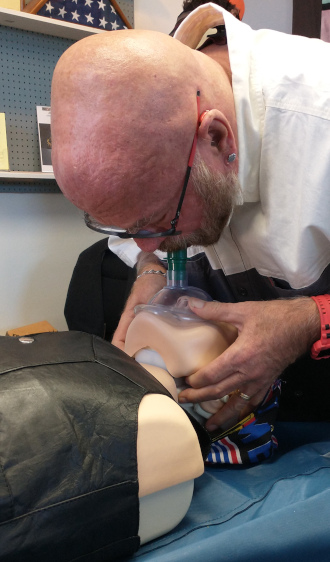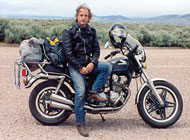Accident Scene Management: Treating The Injured
The previous posts in this series are here: First on the Scene. Safety First. What Next?

If you have one of these fancy gadgets, use it, but probably you’ll need to do regular mouth-to-mouth resuscitation. Note the finger behind the jaw executing the jaw thrust.
The first question you need to ask is, is the person breathing? If they’re not breathing nothing else matters. You can lose some blood, you can lose an arm, but if you are not getting oxygen you’re going to die. Or worse, your body may survive but your brain will not. Irreparable brain damage starts to occur at the five-minute point.
Often it is easy to detect breathing. If it’s not then things get trickier. You will want to look at the chest to see if it is rising and falling. Put an ear near the mouth and listen for breathing. Feel the chest for movement and feel at the nose and mouth for the movement of air.
Realistically, if the person is not breathing they may already be dead. But we don’t know that. So you’ve got to give them oxygen non-stop until the rescue team arrives. Also realistically, they may have injuries that may kill them even if you do give them oxygen. You might find yourself needing to apply a tourniquet at the same time you’re giving them oxygen. Nobody said this was going to be easy.
If you need to give oxygen, and the person is wearing a helmet, you will need to remove it. There is a danger here of causing additional spinal injury but that’s the chance you’re going to have take. Presumably it’s better to be alive and paralyzed than to be dead. If there are two of you then one should stabilize the head and neck while the other removes the helmet. Then stuff anything handy under the head and neck to keep it in the position it was already in. If it’s just you you’re going to have to try your best. But try.
In the training session they talked a lot about barriers and other devices to protect yourself from potential disease. Unless you’re one of those well-prepared types who carry first aid kits you’re not going to have any of those and you’re just going to have to go with regular old mouth-to-mouth resuscitation. But first you’ll need to ensure that the tongue is not blocking the air way.
There’s a move called the jaw thrust where you place your fingers behind the jaw, kind of below the ears, and shove it forward. This separates the tongue from the throat enough for air to pass. Then start breathing into them. You should see the chest rise and fall if you’re doing it right. Keep that up every six seconds (three seconds for a child) until help arrives. This is going to be work and you’re going to get tired. But you need to keep it up unless you reach the point where you absolutely can’t do it any longer. Obviously, if there are others at hand you can trade off.
Bleeding is next. Pressure is always the best way to stop bleeding. With a more serious injury, such as a limb ripped off or an artery torn open, you will need to use a tourniquet. Otherwise this person will bleed to death. Do not apply a tourniquet unless it is absolutely necessary because it may result in the loss of the limb. But it’s better to lose your arm than die.
Often the visible injuries are nowhere near that severe, but that does not mean there are no serious injuries. Internal injuries are harder to detect but can be just as deadly. All the more reason to keep the person right where they are.
And internal injuries are not obvious even to the injured person. One helpful hint from one of the experienced members of the class was that he who screams the loudest is usually the least hurt. But do everything you can to keep someone who says “Hey, I’m fine. Let’s go” from going anywhere for at least 15 minutes, because it could take that long for shock to set in, after the adrenaline fades.
And shock will kill you. You need to keep the person flat, with legs elevated to get blood to the head. Don’t give them anything to drink because that will be a problem if they need surgery. Look for restlessness or irritability; confusion; pale, cool, and moist skin; rapid breathing and/or pulse; nausea; and excessive thirst. Cover them to keep them warm.
Then wait for the rescue guys.
Clearly there’s a lot more, but I can’t begin to cover it all in a few blog posts. That’s why it’s a good idea to take one of these courses yourself.
And clearly it’s not all a simple one, two, three. Everything will vary based on how many people are injured and how badly, how many people are there with you assisting them, and so many other factors. All you do is the best you can do, and that could mean, in a worst case scenario, doing triage and ignoring others who are badly injured while working to save just one or two. You can only do so much.
But at least if you have some idea as to what to do you’re likely to provide more help than if you’re totally clueless. Take the class. And encourage your friends to take it, too. Someone’s life may depend on it some day. Maybe yours.
Biker Quote for Today
It is one of the illusions, that the present hour is not the critical, decisive hour. — Carlyle
